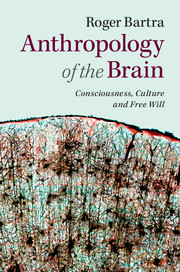Book contents
- Frontmatter
- Contents
- Preface
- Part I Consciousness and symbolic systems
- 1 The hypothesis
- 2 Evolution of the brain
- 3 Brain plasticity
- 4 Is there an internal language?
- 5 Amputations and supputations
- 6 The atrophied exocerebrum
- 7 The symbolic substitution system
- 8 Neuronal mirrors
- 9 Consciousness within hand’s reach
- 10 Outside and inside: the immense blue
- 11 The musical spheres of consciousness
- 12 Artificial memory
- 13 The lost soul
- Part II Brain and free will
- Bibliography
- Index
8 - Neuronal mirrors
Published online by Cambridge University Press: 05 June 2014
- Frontmatter
- Contents
- Preface
- Part I Consciousness and symbolic systems
- 1 The hypothesis
- 2 Evolution of the brain
- 3 Brain plasticity
- 4 Is there an internal language?
- 5 Amputations and supputations
- 6 The atrophied exocerebrum
- 7 The symbolic substitution system
- 8 Neuronal mirrors
- 9 Consciousness within hand’s reach
- 10 Outside and inside: the immense blue
- 11 The musical spheres of consciousness
- 12 Artificial memory
- 13 The lost soul
- Part II Brain and free will
- Bibliography
- Index
Summary
Not only have some neurologists wanted to reveal the mystery of consciousness, but they have also attempted to discover the secrets of genius. The idea that the answer to the enigmas of consciousness must be locked inside the heads of history’s most brilliant personalities has translated into an extreme curiosity on the part of certain scientists (and not a few charlatans) to carry out studies directly on the brains of geniuses. Slices of Albert Einstein’s brain were given out to various scientists by the pathologist who performed his autopsy. This man kept the thinking organ of the great physicist in a jar for forty years. Close to the end of his life he decided to turn over what was left of it to the genius’s granddaughter and so he traveled across the United States by car with the mortal remains. The neurologist Marian Diamond, of the University of California, examined some slices and could only determine that there was a large concentration of glial cells in the area of association (area 39 of the left hemisphere) of Einstein’s brain that was greater than in other sections. Apart from that, neither she nor any of the others could find the secret of genius. Of course there had been previous cases of great thinkers whose brains ended up in scientists’ laboratories, such as the mathematicians Carl Friedrich Gauss and Sonja Kovaleski. Another famous brain that was the subject of detailed study was that of Lenin. Oskar Vogt, an important German neurologist, was hired by the Soviet government to discover the unique and extraordinary nature of the brain of the great leader of the October Revolution. Vogt, in his laboratory in Berlin, had developed refined techniques for cutting the brain into seriated sections for their study. This physician was looking for relations between mental processes and what he called the “architectonics” of the brain. Korbinian Brodmann carried out his studies of mammalian cerebral cortex cytoarchitecture in Vogt’s laboratory, culminating in 1909 in the famous monograph that established fifty-two cortical areas.
- Type
- Chapter
- Information
- Anthropology of the BrainConsciousness, Culture, and Free Will, pp. 51 - 59Publisher: Cambridge University PressPrint publication year: 2014



